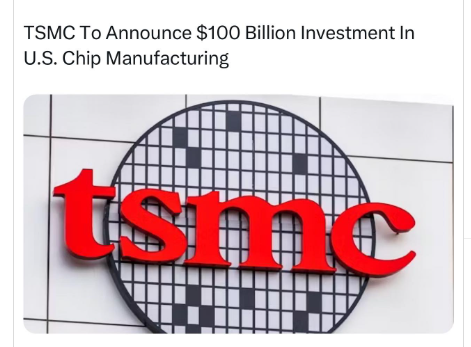Few announcements in the high-stakes technology sector have the same wide-ranging impact as Taiwan Semiconductor Manufacturing Company’s most recent commitment: a $100 billion expansion into the U.S. semiconductor market. This audacious move signifies more than just a financial infusion; it marks a seismic shift in the location and mode of powering the global AI future.
By incorporating two state-of-the-art packaging facilities and three state-of-the-art fabrication plants into Arizona’s desert sprawl, TSMC is successfully securing America’s comeback as a semiconductor superpower. The Taiwanese chip giant, which is essential to the goals of NVIDIA, Apple, AMD, and the larger AI ecosystem, has now made an astounding $165 billion total U.S. investment, which is far more than any previous foreign tech investment made in the United States.
TSMC’s U.S. Semiconductor Expansion
| Category | Details |
|---|---|
| Company Name | Taiwan Semiconductor Manufacturing Company (TSMC) |
| Total U.S. Investment | $165 billion (including new $100 billion announcement) |
| New Facilities | 3 chip fabs, 2 packaging sites in Arizona |
| Jobs Created | 40,000 construction jobs; tens of thousands of high-tech roles |
| First Fab Start Date | Late 2024 (volume production started) |
| U.S. Locations | Phoenix, AZ; Camas, WA; Austin, TX; San Jose, CA |
| Supported Partners | Apple, NVIDIA, AMD, Broadcom, Qualcomm |
| Government Subsidies | $6.6 billion from U.S. Commerce Department |
| CEO Statement | “AI is reshaping our lives. Semiconductor tech is the foundation.” — C.C. Wei |
| Source | TSMC Official Source |
Chips, AI, and a Strategic Westward Turn
Taiwan’s President Lai Ching-te claims that TSMC’s action was not the result of political pressure, at least not formally. However, supply chains for silicon and geopolitics are becoming more and more intertwined. TSMC’s Arizona expansion is a well-timed lifeline to domestic AI ambitions amid rising U.S.-China tensions and Washington’s drive to “reshore” vital industries.
President Trump’s earlier accusations that Taiwan was “stealing” America’s technological advantage seem to have given way to a more calculated discussion that combines national security concerns, AI collaborations, and infrastructure incentives into a single, heavily subsidized semiconductor push.
Why $100 Billion Is a Supply Chain Reset, Not Just a Symbol
TSMC CEO C.C. Wei claims that the current U.S. fab capacity is unable to keep up with the exponential increase in customer demand. TSMC intends to bring advanced packaging, high-yield nodes, and sub-3nm manufacturing to the US market. These technologies are essential to NVIDIA’s rapid AI acceleration, Apple’s custom silicon innovation, and Qualcomm’s mobile ambitions.
The $100 billion will be used for more than just capacity expansion. A full onshore AI supply chain, including design centers, packaging facilities, and possibly even research hubs, will be established as a result. Such closeness is incredibly effective for lowering latency, logistics costs, and strategic risk in an industry that is becoming more and more defined by real-time computation and edge inferencing.
Economic Impact: The Emergence of a Semiconductor Boomtown
This initiative is anticipated to create over $200 billion in indirect economic activity over the next ten years, igniting a high-tech ecosystem in Phoenix that may compete with Silicon Valley’s hardware industry. With 3,000 workers on site and more than 1,100 acres already committed, the Arizona hub is quickly evolving into a new hub for chip production worldwide.
In ways previously exclusive to East Asia, TSMC is optimizing chip design-to-manufacture cycles by utilizing both government assistance and customer partnerships. Additionally, with a network spanning California, Texas, and Washington, the company is developing a multi-nodal platform that can adapt to changes in the market or supply shocks.
Worldwide Consequences: China, Taiwan, and the Silicon Shield
The growth of TSMC has not been without challenges. Taiwanese critics worry that outsourcing advanced manufacturing could erode the island’s “silicon shield,” or the strategic advantage it enjoys because of its essential chip production. However, TSMC maintains that Taiwan continues to be its innovation hub and that 10,000 engineers are still working on 1.0-nanometer technology domestically.
China’s response is still subdued but cautious. Semiconductors are now a matter of geopolitical currency rather than just commercial advantage, as AI accelerators and autonomous systems increasingly become military-relevant technologies.
From Arizona to AI Worldwide: What’s in Store for the Future
By making this enormous investment, TSMC is establishing itself as the brain center of a trillion-dollar AI economy rather than merely constructing factories. The chips made in Arizona will probably be used in almost every facet of digital life, whether they are driving conversational bots, driverless cars, or real-time scientific research.
Compute needs will skyrocket in the upcoming years as agentic AI grows increasingly independent and context-aware. TSMC is future-proofing not only its business model but the whole AI ecosystem it supports by growing ahead of demand.


